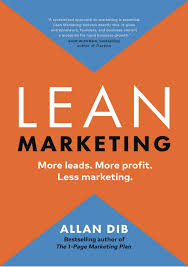Allan Dib's "Lean Marketing" is a powerful framework that emphasizes simplicity, efficiency, and measurable results. This white paper will delve deeper into the core principles and strategies outlined in the book, providing a comprehensive overview of how businesses can implement Lean Marketing to achieve significant growth.
Lean Marketing: A Comprehensive White Paper
Introduction
Allan Dib's "Lean Marketing" is a powerful framework that emphasizes simplicity, efficiency, and measurable results. This white paper will delve deeper into the core principles and strategies outlined in the book, providing a comprehensive overview of how businesses can implement Lean Marketing to achieve significant growth.
Core Principles of Lean Marketing
- Focus:
- Identify Your Ideal Customer: Clearly define your target audience to tailor your marketing efforts.
- Craft a Compelling Offer: Develop a unique selling proposition (USP) that resonates with your target market.
- Simplify:
- Eliminate Clutter: Remove unnecessary marketing activities and focus on what truly drives results.
- Streamline Processes: Optimize your marketing workflows to increase efficiency.
- Systematize:
- Create a Repeatable System: Establish a consistent marketing process to ensure long-term success.
- Leverage Automation: Utilize marketing automation tools to save time and effort.
- Scale:
- Expand Your Reach: Once you've found a winning formula, scale your marketing efforts to reach a wider audience.
- Replicate Success: Implement your successful marketing strategies across multiple channels.
Key Strategies from Lean Marketing
- The 1-Page Marketing Plan:
- A simple, visual tool to outline your marketing strategy, including your target market, unique selling proposition, key marketing messages, and call to action.
- The 5-Step Marketing Machine:
- A step-by-step process for attracting, converting, closing, and delighting customers.
- Content Marketing:
- Create high-quality content that attracts and engages your target audience.
- Use content to establish thought leadership and build trust.
- Social Media Marketing:
- Leverage social media platforms to connect with your audience, share valuable content, and drive traffic to your website.
- Email Marketing:
- Build an email list and nurture leads with targeted email campaigns.
- Paid Advertising:
- Use paid advertising channels (e.g., Google Ads, Facebook Ads) to reach a wider audience.
- Public Relations:
- Generate media coverage and build brand awareness through press releases, media pitches, and influencer partnerships.
Implementing Lean Marketing: A Step-by-Step Guide
- Assess Your Current Marketing Efforts:
- Identify areas of strength and weakness.
- Determine which marketing activities are driving the best results.
- Define Your Ideal Customer:
- Create detailed customer personas to understand their needs, wants, and pain points.
- Craft a Compelling Offer:
- Develop a unique selling proposition that differentiates your business from competitors.
- Build a Strong Brand:
- Create a consistent brand identity and messaging.
- Implement a Marketing System:
- Use a project management tool to organize and track your marketing activities.
- Measure and Optimize:
- Track key metrics (e.g., website traffic, leads generated, sales) to measure the effectiveness of your marketing efforts.
- Continuously test and refine your marketing strategies.
Conclusion
By applying the principles of Lean Marketing, businesses can achieve significant growth with minimal effort. By focusing on what matters, simplifying processes, and leveraging data-driven insights, you can create a sustainable and profitable marketing machine.
For further exploration, consider these additional resources:
- Allan Dib's Website:
- Books:
- "The 1-Page Marketing Plan" by Allan Dib
- "Jab, Jab, Jab, Right Hook" by Gary Vaynerchuk
By embracing Lean Marketing, you can transform your business and achieve lasting success. Contact keencomputer.com for details.
